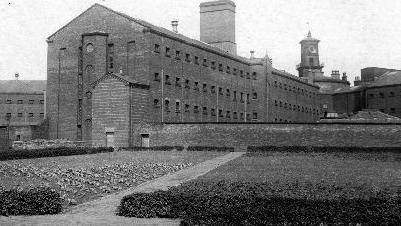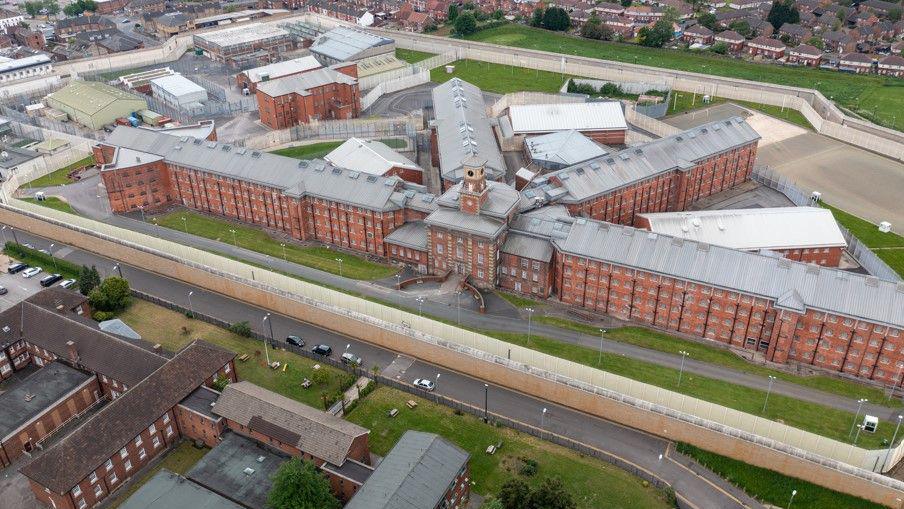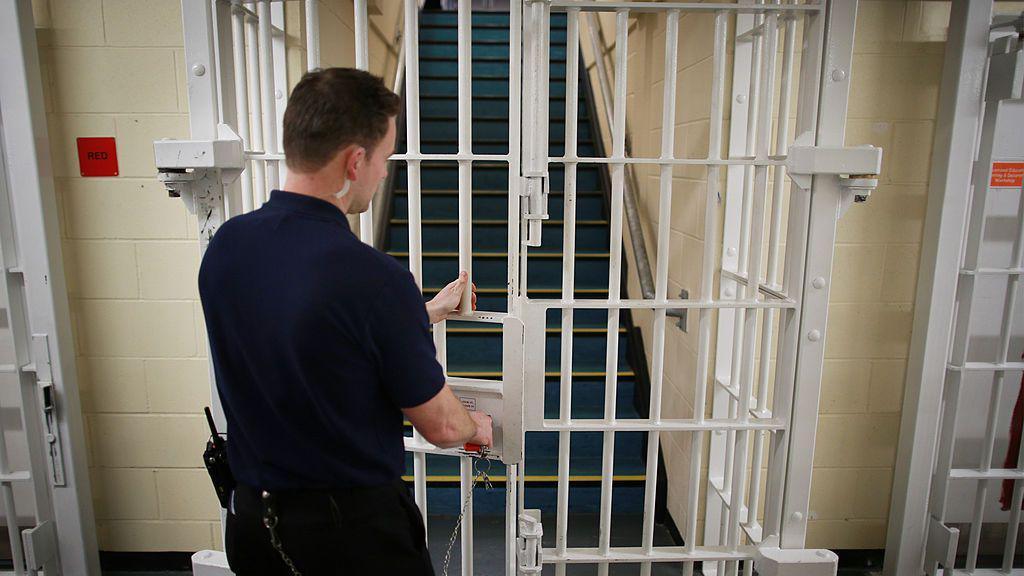Heinous crimes and nursery rhymes: Inside HMP Wakefield

Wakefield Prison, pictured in 1914, has housed some of the UK's most notorious criminals
- Published
The towering walls of HMP Wakefield have been home to some of the UK's most notorious and violent criminals, from serial killer GP Harold Shipman and armed robber Charles Bronson to paedophile singer Ian Watkins.
Watkins' recent death, and that of child killer Kyle Bevan on Wednesday, followed a report in September which highlighted a sharp rise in violent incidents which indicate the challenges facing one of the country's most secure sites.
Imposing and austere, HMP Wakefield is one of the UK's 10 Category A high-security prisons.
Behind razor wire-topped walls, those incarcerated there are deemed to pose the most severe threat to the public, police or national security – with many serving indeterminate or life sentences.
Situated close to bustling shopping streets and overlooked by travellers on platform two of the nearby Westgate railway station, the jail has been an ever-present on the site since the first "house of correction" was built on Love Lane more than 400 years ago.
At the time of its last inspection, the historic redbrick jail was being used to hold 630 prisoners, including 148 Category A offenders, with around two-thirds of the inmates convicted of sexual offences.
Due to the large proportion of sex offenders and murderers among its population, it has earned the grim nickname Monster Mansion.
Violence is not uncommon on the four main wings of the jail.
A report by His Majesty's Inspectorate of Prisons published, external in September found there had been a 62% rise in violent incidents, with 183 recorded in the previous year.
It said "many" prisoners reported feeling unsafe, "particularly older men convicted of sexual offences".
A separate report by the Independent Monitoring Board published, external in February, recorded 136 incidents of prisoner-on-prisoner violence, with another 136 occurrences of prisoner-on-staff violence.

Serious assaults have risen by 62% at the prison, according to a recent report by inspectors
Dr Emma French, co-author of Inside Wakefield Prison: Life Behind Bars in the Monster Mansion, said high-profile criminals like the former Lostprophets frontman Watkins, who was serving a 29-year jail sentence for child sex crimes, were particularly at risk of attacks during their time behind bars.
She said the nature of his crimes would also have singled him out.
"There's definitely a kind of honour amongst thieves in prison, if you are, say a gangster who's in there for grievous bodily harm, they'll be just as sickened by Watkins' crimes as you and I are," she said.
"There's a sort of hierarchy where, particularly, paedophiles are the lowest of the low.
"Paedophiles hang out together, so Ian Watkins would probably have had a sort of weird little group of fellow paedophiles and sex offenders."
Asked about any rising threat to staff at the jail she added: "There's a feeling amongst the amazing people who work in the prison system, that unfortunately it's only a matter of time before an officer gets killed."
'Bolster security'
Responding to Dr French's claims the Ministry of Justice said it was investing £40m nationally to boost safety, combat the influx of drone activity and clamp down on suspected wrongdoing behind bars.
This includes security enhancements such as window replacements, CCTV and control room upgrades, vehicle gates and floodlighting.
A spokesperson added: "The government has made it clear it will do whatever we can to protect our hardworking staff – which is why we are trialling tasers in prisons and mandated protective body armour for prison officers working with the most dangerous offenders.
"But we're going further to bolster security in our prisons, including an increase in the number of full searches to intercept dangerous contraband that fuels violence behind bars."
Speaking in April, Mark Fairhurst, chair of the Prison Officers' Association, said he did not believe a trial of tasers was necessary and called for their use to be rolled out "before one of my members is murdered".

D wing at the prison, which includes netting to protect prisoners who may fall from landings, pictured in 2004
The MoJ's own statistics show there were six homicides across the England and Wales prison system in the 12 months to September 2025.
That excludes the death of Watkins at Wakefield on 11 October and that of Bevan, jailed for life for murdering his partner's two-year-old daughter, on Wednesday.
Andrea Coomber, chief executive of the Howard League for Penal Reform, said the incidents speak "to problems within the prison system more generally and beyond this individual prison".
She described a "serious crisis" of violence and unsafe prisons.
But she added that the two deaths put "Wakefield into a category of its own, which is a dire state of affairs and I'm sure is a cause of huge concern for people running the prison and living in the prison".
"In a prison like Wakefield you've got lots of people serving very long sentences.
"It is difficult to keep people invested in abiding by the rules because they've got another 25 or 30 years left in prison. These are complicated places with complicated people."
Notorious roll call
Current inmates include Jack Renshaw, the neo-Nazi paedophile who plotted to kill Labour MP Rosie Cooper and Reynhard Sinaga, dubbed the UK's most prolific rapist.
Roy Whiting, who killed eight-year-old Sarah Payne, and Sinaga, jailed for 159 sex offences against men in 2020, have allegedly been attacked at the prison within the last year.
Watkins spent 12 years behind bars before he was fatally stabbed. Two men accused of his murder are set to stand trial. Three men accused of murdering Bevan appeared in court on Friday.
Violence is nothing new at the prison, which was first built in the late 16th Century and later became a site of executions and hangings.
"Wakefield was still just a small town when it was built as a house of correction in 1595," Kevin Trickett from the Wakefield Civic Society explained.
"There's evidence back then that prisoners had to pay their own jailers to look after them."
By the time the prison was rebuilt on its current site during the Victorian era, a Dickensian poorhouse and the West Riding Lunatic Asylum were both located in close proximity.
A police station and magistrates' court were also sited nearby.

During the Cold War, the jail housed prisoners conviected of espionage, including Soviet spy Morris Cohen (pictured above) as well as Klaus Fuchs, who leaked nuclear secrets to the USSR
"If you weren't a conforming member of society then there was somewhere to put you," Mr Trickett said.
"During World War One, the prison was cleared and they put conscientious objectors [people who claimed the right to refuse military service] in there.
"They were often taken out to do work during the day."
In 1918, six of these conscientious objectors had to be sheltered at the home of two sisters, who lived on nearby Quebec Street, as they were pursued by an angry mob indignant at their refusal to fight in the trenches.
According to the Forgotten Women of Wakefield project, external, which successfully secured a blue plaque for Nellie and Emily Staynes in 2019, the two sisters hid the men in their cellar before "throwing loose tiles and mounds of earth from their roof" as the crowd below became violent.

A mulberry bush is believed to have grown in the prison grounds for centuries
Away from the violence and notoriety, the prison also holds a place in British folklore, with the nursery rhyme Here We Go Round the Mulberry Bush said to have originated at the jail.
In the 19th Century, female inmates were said to have danced around the mulberry tree in an effort to keep warm.
Some are thought to have turned the ritual into a rhyme to entertain their children.
The plant has become part of the prison's identity with the staff canteen called "The Mulberry".
The tree, which stood on the main route that modern prisoners take on a daily basis to get to the prison's workshops, stood at the site until 2019, when it was chopped down due to disease.
However, a cutting taken from the bush was later replanted at the nearby Yorkshire Sculpture Park.
Get in touch
Tell us which stories we should cover in Yorkshire
Listen to highlights from West Yorkshire on BBC Sounds, catch up with the latest episode of Look North.
Related stories
- Published29 September

- Published22 April
